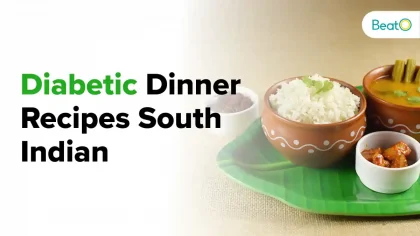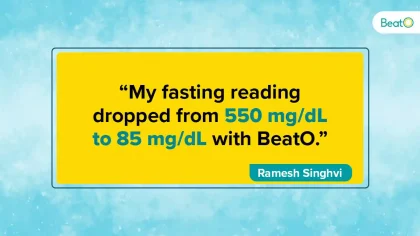Managing diabetes can be challenging nowadays. People tend to attract junk, spicy and unhealthy food items. However, South Indian cuisine can provide balanced, low-carb, high-fibre, and nutrient-dense meals that are both tasty and healthful for those with diabetes. Moreover, there are numerous diabetic dinner recipes South Indian style you can try to manage your diabetes effectively.

This post offers a wide range of options for diabetic patients, including five quick and simple South Indian diabetic supper dishes. These dishes are ideal for controlling blood sugar levels while consuming delicious meals. Read on to know everything about the diabetic dinner recipes South Indian style that are quite easy and quick to make.
Also read: Your Essential Guide: Gestational Diabetes South Indian Diet Plan
5 Easy and Quick South Indian Diabetic Dinner Recipes
Looking for easy and quick South Indian diabetic dinner recipes? No need to worry! Here, we’ve listed seven delicious yet nutritious South Indian dinner recipes for diabetics.
| S.no. | Recipe Name |
| 1. | Oats Pongal |
| 2. | Spinach Dosa |
| 3. | Kootu Curry |
| 4. | Ragi Idli |
| 5. | Cabbage Poriyal |
Also read:Top Picks: South Indian Vegetarian Recipes For Diabetics
Oats Pongal
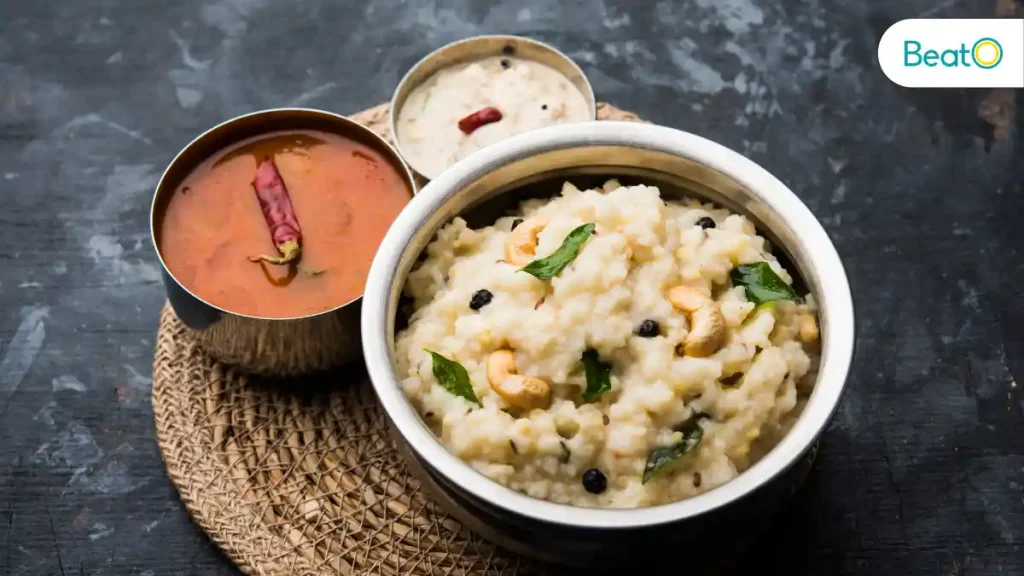
Did you know that oats are a great source of soluble fibre, lowering cholesterol and promoting intestinal health? Because it doesn’t utilize white rice, this recipe is a healthier take on the classic Pongal. It is quite delicious and easy to prepare; this is also my personal go-to dish. When cooking, make sure not to use ghee; instead, use a small amount of canola oil (just a few drops, please). Serve this with some lovely channa daal chutney and some steamed veggies.
Ingredients:
- 1 cup oats
- 1/2 cup split yellow moong dal
- 1 tsp cumin seeds
- 1 tsp black peppercorns
- 1-inch piece ginger, grated
- 1 tbsp ghee (optional)/ Canola oil
- 1 tsp mustard seeds
- 1/2 tsp asafoetida (hing)
- Curry leaves
- Salt to taste
- 3 cups water
How to Prepare:
- Over medium heat, dry roast the oats for 3–4 minutes or until lightly toasted. Put aside.
- Moong dal should be washed and cooked in two cups of water till tender. It can be cooked under pressure for two whistles.
- Curry leaves, mustard seeds, cumin seeds, and black peppercorns are added to heated ghee or oil in a pan.
- Stir in the grated ginger and cook for one minute.
- Add one cup of water and the cooked moong dal. Blend thoroughly.
- Add the salt and the roasted oats. Stir often to prevent clumping.
- Once the oats are thoroughly cooked and have the consistency of porridge, simmer for a further five minutes.
- Garnish with chopped coriander leaves and serve hot.
Benefits for Diabetics: Rich in dietary fibre, oats Pongal enhances digestion and aids in blood sugar regulation. Oatmeal with moong dal has a low glycemic index, which makes it perfect for diabetic management.
Also read: South Indian Snacks For Diabetics: 7 Delicious And Healthy Options
Spinach Dosa
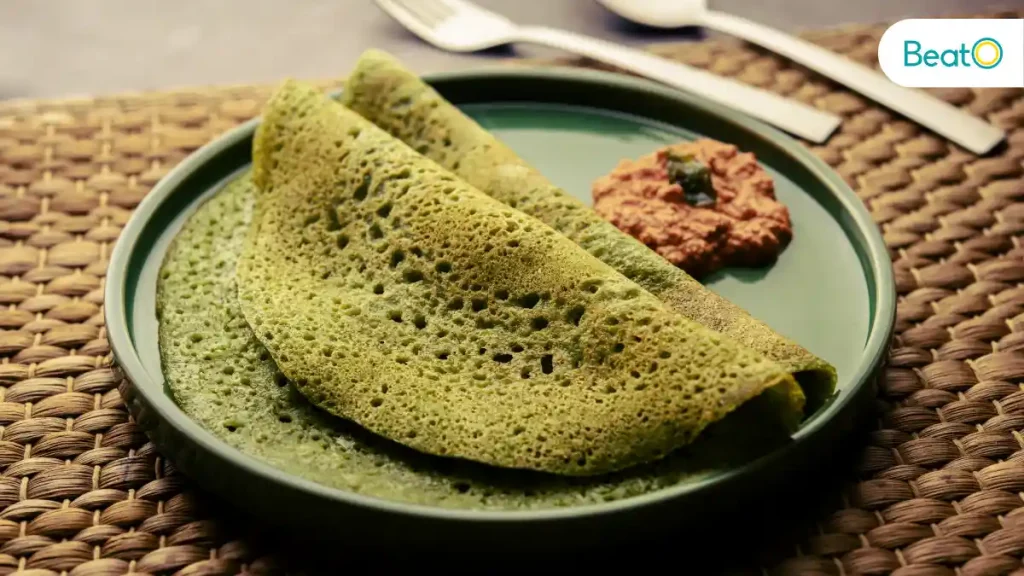
Ingredients:
- 1 cup dosa batter (made from fermented rice and urad dal)
- 1 cup finely chopped spinach
- 1 small onion, chopped
- 1 green chili, chopped
- 1 tsp cumin seeds
- Salt to taste
- Oil for cooking
How to Prepare:
- Add the chopped onions, cumin seeds, green chile, and spinach to the dosa batter, along with the salt.
- A ladleful of batter should be poured into a heated non-stick pan and spread thinly to produce a dosa.
- Coat the edges with a few drops of oil and fry until one side is golden brown.
- Cook for a few seconds on the other side after flipping.
- Serve hot with sambar or coconut chutney.
Benefits for Diabetics: Spinach dosa is a nutrient-dense food high in iron and fibre and loaded with antioxidants. In addition to providing vital vitamins and minerals and aiding in blood sugar stabilization, spinach also improves general health.
Also read: The Ultimate Guide To South Indian Diabetic Diet Chart
Kootu Curry
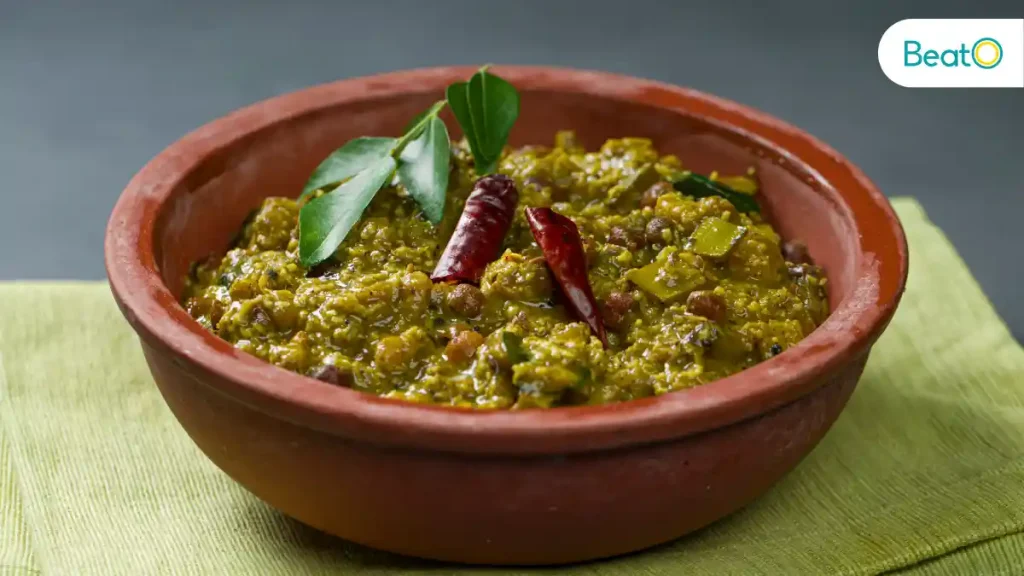
Ingredients:
- ⅓ cup black chana (black chickpeas)
- ¼ teaspoon salt
- 1.5 cups water
- 1 to 1.25 cups plantain (raw banana)
- chopped1 cup elephant foot yam (suran)
- chopped¼ teaspoon turmeric powder
- ¼ teaspoon black pepper powder
- 1.5 cups water
- ½ teaspoon salt
- 1 teaspoon jaggery (optional)
- ¼ cup water (optional)
- ½ cup fresh grated coconut
- 1 teaspoon cumin seeds
- 2 dry red chilies (seeds removed)
- ½ cup water
- 2 tablespoons coconut oil
- ½ teaspoon mustard seeds
- ½ teaspoon urad dal (split black gram)
- 8 to 10 curry leaves
- 1 dry red chilli
- ⅓ cup fresh grated coconut
How to Prepare:
- Rinse and soak ⅓ cup black chana in water for the entire night.
- After draining, simmer for 10 minutes or 12–14 whistles in a pressure cooker with 1.5 cups water and ¼ teaspoon salt. After draining, set away.
- Peel and chop one cup of elephant foot yam and one to 1.25 cups of plantain.
- Combine them with ¼ teaspoon each of black pepper, turmeric, and salt in a skillet with 1.5 cups of water.
- When the vegetables are soft, cook them covered over low to medium heat, stirring now and then. Add extra water as necessary.
- After the vegetables are done, add the cooked chickpeas and simmer, uncovered, to evaporate any extra water.
- Add the coconut paste to the chickpeas and vegetables. If the curry be too thick, add ¼ cup water. Add 1 teaspoon of jaggery, if desired.
- After bringing the mixture to a boil, simmer it until the raw flavour of the red chillies and coconut is gone. After turning off the heat, cover.
- In a small pan, heat up two teaspoons of coconut oil. Add ½ teaspoon of mustard seeds and ½ teaspoon of urad dal; heat until the dal turns golden and the mustard seeds crackle.
- Add ⅓ cup grated coconut, 1 dry red chile, and 8 to 10 curry leaves. The coconut should be sautéed until golden brown.
- Stir thoroughly after adding the tempering to the kootu curry. For a few minutes, cover and allow the flavours to mingle.
Benefits for Diabetics:
Kootu Curry combines high-fibre legumes like black chickpeas with low-glycemic veggies like plantains, making it a diabetic-friendly food. Because the dish contains slow-releasing carbohydrates, it helps control blood sugar levels. Due to its high dietary fibre content, it helps to keep blood glucose constant and encourages fullness.
Ragi Idli
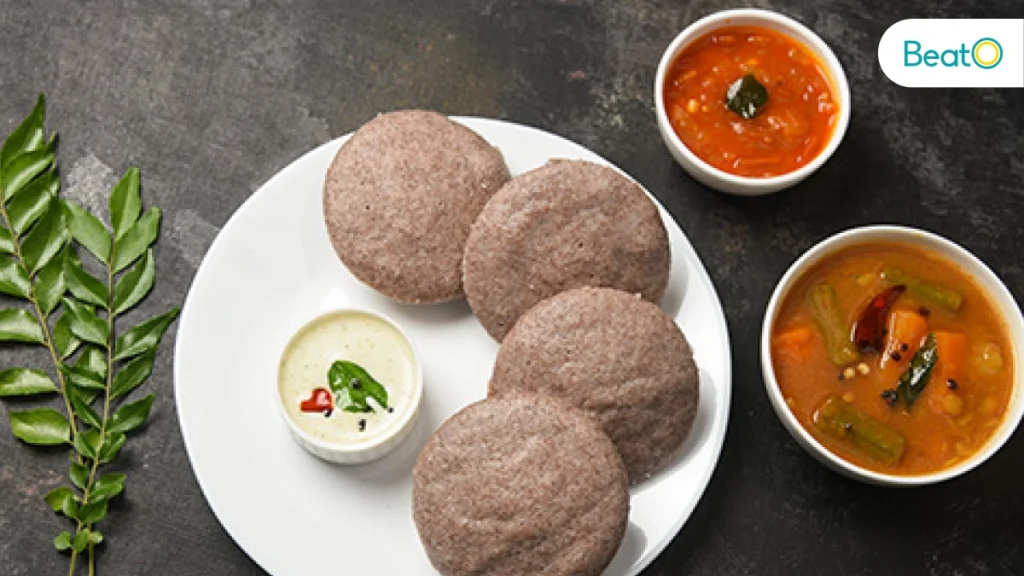
Ingredients:
- 1 cup ragi flour
- 1 cup idli rice
- 1/2 cup urad dal
- 1/4 tsp fenugreek seeds
- Salt
How to Prepare:
- Wash rice and dal separately.
- Soak each in water for 4 to 6 hours.
- Drain water from rice and dal.
- Grind rice with a little water to a smooth paste.
- Do the same with dal.
- Combine both pastes in a large container.
- Mix ragi flour and salt into the paste.
- Cover and let the mixture ferment overnight.
- The next morning, fold the risen batter gently.
- Add 1 teaspoon of baking soda and mix well.
- Grease idli moulds with oil.
- Pour a ladleful of batter into each mould.
- Place the moulds in a steamer and steam for 8 to 10 minutes.
- Insert a skewer or toothpick into an idli; it should come out clean.
- Let the idlis cool for 5 minutes.
- Use a spoon dipped in water to gently remove the idlis from the moulds.
- Place idlis in a hot case to keep warm.
- Serve hot with tomato chutney.
Benefits for Diabetics:
Ragi Idli is the healthiest option for diabetics. Due to its high calcium, iron, and dietary fibre content, it is a low-glycemic index, heart-healthy food that promotes metabolic health by stabilising blood sugar levels.
Also read: Guide To South Indian Breakfast For Diabetic Patients You’ll Love
Cabbage Poriyal
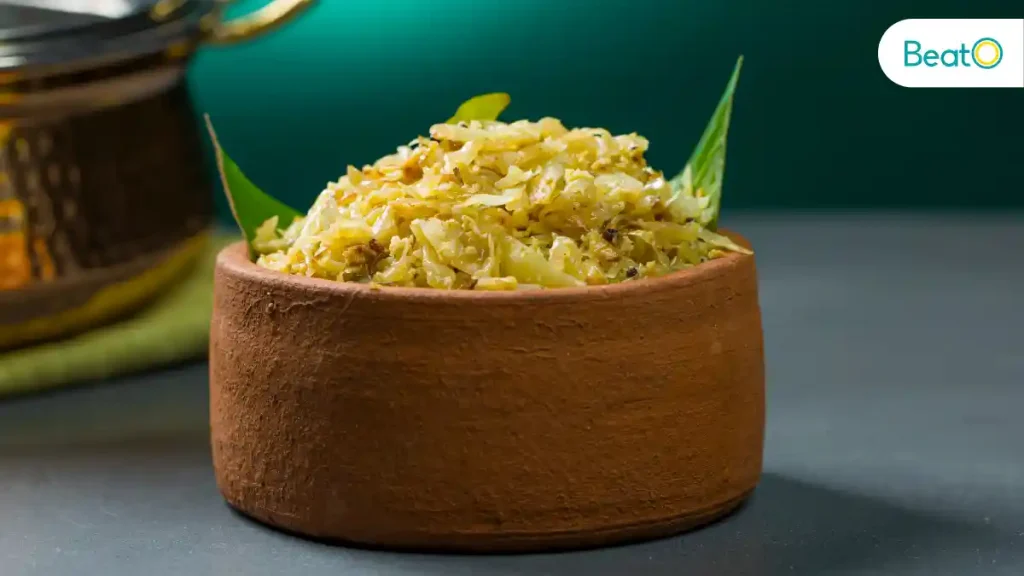
Ingredients:
- 2 cups shredded cabbage
- 1/2 cup grated coconut
- 1 tsp mustard seeds
- 1 tsp urad dal
- 1 dried red chili
- Curry leaves
- Salt
- 1 tbsp oil
How to Prepare:
- Heat oil in a pan and add mustard seeds, urad dal, red chili, and curry leaves.
- Add shredded cabbage and sauté until tender.
- Mix in the salt and grated coconut.
- Serve hot after cooking for a few more minutes.
Benefits for Diabetics:
Cabbage Poriyal is low in calories and high in nutritional fibre. Also, it aids in blood sugar regulation and digestive wellness. The taste is enhanced and healthy fats are added with the addition of coconut.
Final Words
To sum up, there are a ton of delicious and nutritious diabetic dinner recipes South Indian style to choose from. However, these 5 South Indian dishes offer a well-rounded strategy for managing diabetes by emphasising nutritious grains, legumes, and vegetables. If you want to eat a variety of tasty and healthful meals while keeping your blood sugar steady, try these simple and quick South Indian dishes for supper. Also, comment below which one is your favourite among these options.
Disclaimer: The content of this article is compiled information from generic and public sources. It is in no way a substitute, suggestion, or advice for a qualified medical opinion. Always consult a specialist or your own doctor for more information. BeatoApp does not claim responsibility for this information.
Click here if you’re looking to buy aglucometeronline or want to book an online health coach. Beatoapp will help you right at your doorstep.
Looking for a seasoned diabetologist? ChooseDr. Navneet Agarwal, an expert with 25+ years of experience. His specialisation in diabetology and obesity management provides personalised care. Elevate your health with a doctor’s recommendedglucometer, buy now.

